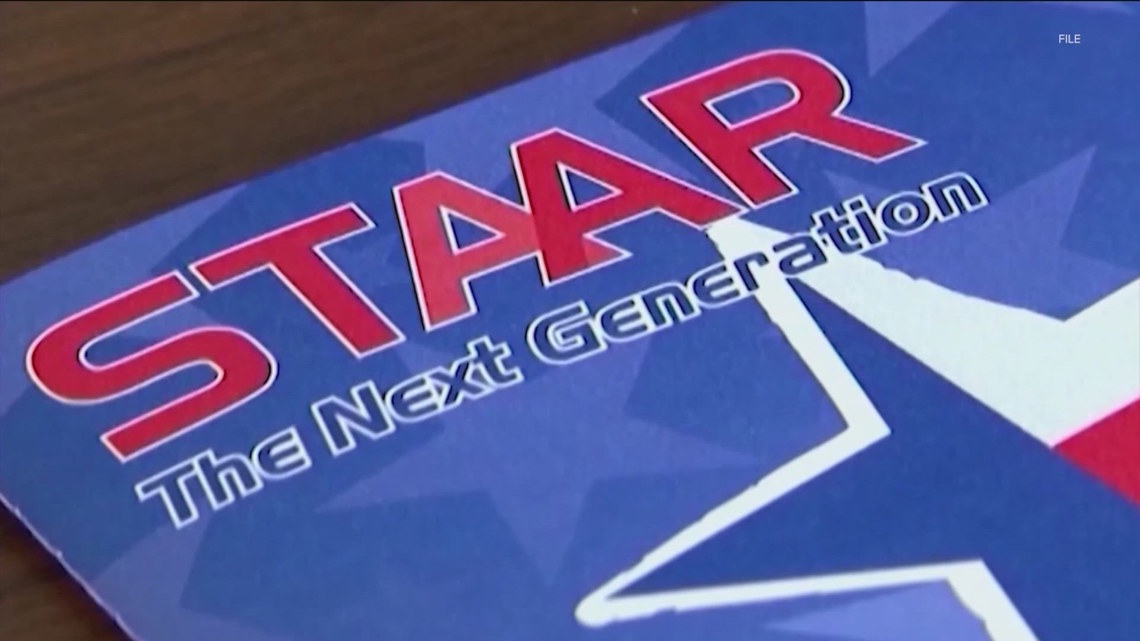
The assessment shows less than half of Texas high schoolers are meeting performance expectations in math.
AUSTIN, Texas — The Texas Education Agency (TEA) released Spring STAAR test results on Tuesday for high school end-of-course exams.
The results showed slight changes in the performance of Texas students on this year’s STAAR test when compared to last year. In algebra 1 and biology, students did better, while in English I, English II and U.S. history, students did worse.
The TEA said this year’s STAAR test results show modest year-over-year changes in performance.
The percentage of students meeting grade level in algebra 1 increased by 2%, from 45% to 47%.
The assessment shows less than half of Texas high schoolers are meeting performance expectations in math and are still 15 points behind pre-pandemic levels.
The most significant increase came in biology, where the number of students meeting grade level jumped 5 points from 57% to 62%.
Meanwhile, in English I, there was a 3% drop, from 54% to 51%, and a 4% drop from 56% to 52% for English II. There was a slight 1% decline in the percentage of students meeting grade level for U.S. history, which is the strongest section for students.
Gabe Grantham, an education policy advisor for Texas 2036, said the data concerns him.
“After the pandemic, we saw sharp increases as part of the recovery, and we hit a peak. Now we’re starting to see the first slipping of that,” Grantham said. “I think it’s a call for a renewed effort to focus on literacy and reading achievement in Texas, especially in those later grades.”
In Education Service Center Region 13, which encompasses 53 school districts in Central Texas including Austin, students experienced slight declines in every category except algebra 1. The number of students who met the grade-level requirements in algebra 1 increased by 1 point, while the numbers in biology and English I dropped by 3 points; English II dropped by 4 points and U.S. history dropped slightly by 1 point.
In Austin, students showed gains in algebra 1 and biology but declined in English and held steady in U.S. history.
Austin ISD students saw a 4-point gain in algebra 1, from 39% last year to 43% this year, which was larger than the statewide improvement numbers. In biology, 63% of students met grade level, a 5% increase from the 57% who did in 2024.
The number of students who met grade level on English I decreased by 1 percentage point, from 52% last year to 51% this year, and the number of students who met grade level on English II dropped by 4 points, from 58% last year to 54% this year. U.S. history remained steady at 71% and showed no change year over year.
“This decline means that we’re leaving more and more kids behind in terms of grade-level proficiency,” Grantham said. “The state has to take a proactive approach going into the next few years of school to make sure that we are catching more kids up and getting more kids that grade-level standard.”
The results show notable gaps among economically disadvantaged and minority students.
Among AISD students in algebra 1, 26% of Hispanic students and 17% of Black students met grade-level expectations, well behind 41% and 35% statewide.
For English I, 34% of Hispanic and 33% of Black students met grade level in AISD compared to 43% and 40% statewide, and on English II, only 39% of Hispanic and 36% of Black students met grade level in Austin compared to 49% and 45% statewide.
Twenty-one percent of economically disadvantaged students in AISD met the algebra 1 grade level this year, which is below the state rate of 38% for students in similar situations.
In English I, 29% of AISD’s economically disadvantaged students met grade level compared to 39% statewide. On English II, 31% of Austin’s economically disadvantaged students met grade level this year compared to 45% statewide.
“We see some persisting gaps that exist across every one of the subjects, and until we can close those gaps, we’re going to continue to see a lack of opportunity for certain students across the state along the lines of income and race,” Grantham said.
In biology, the TEA reported that statewide scores improved for all students, including economically disadvantaged students, students receiving special education services and emergent bilingual students.
“Texas students and educators continue to work hard to demonstrate academic excellence,” said Texas Education Commissioner Mike Morath. “At the same time, we also recognize that too many students are still not where they need to be academically. Using a reliable system of assessments, we can continue making progress on the strategies that are most effective in improving student learning and long-term success.”
While this year’s STAAR test results show an increase in the percentage of Emergent Bilingual (EB) students who met grade level on the biology assessment, that was not the case for all of the subjects. An EB student is defined as a student in the process of learning English who has another language as their primary language.
EB students saw an increase in biology, rising 2 percentage points, but experienced a drop of 5 points in English I and II and 3 points in U.S. history, according to the results. Algebra I stayed the same. Twenty-four percent of the state’s 5.5 million public school students are classified as EB.
“These provide a snapshot for our high school level students, but we recognize that education across the board builds upon itself,” Grantham said. “We need to make sure that our students are receiving high-quality instruction through well-trained teachers, through high-quality curriculum being presented in the classroom, and to ensure and ensuring that we are investing in really proven strategies that can be scaled across the state.”
A more detailed statewide summary of this year’s STAAR test results, complete with graphs, can be found here.
The TEA has been using STAAR test results since the 2011-12 school year to grade schools. However, many parents and teachers believe those scores don’t reflect all of the ways schools serve kids, nor do they believe the tests cover everything students should learn.
In this legislative session, state lawmakers considered legislation to replace the STAAR test in the next school year, but it died in the closing days of the legislative session.
HB 4 would have replaced the end-of-year STAAR test with three shorter tests throughout the year: one at the start, one at the middle and one at end.
While House and Senate lawmakers were both in favor of eliminating the test, they could not resolve their disagreements in closed during negotiations during a conference committee on other aspects of the bill, such as what the new replacement test would look like and the A to F rating system, while grades schools’ performance based on the standardized test results.
For parents and guardians, the TEA encourages them to log into their school district’s family portal or TexasAssessment.gov to view their child’s individual STAAR test results.
STAAR results for third through eighth grade will be made publicly available on June 17. That day, parents and guardians will be able to view their child’s results using a unique access code provided by their child’s school or by logging into their school district’s family portal.
